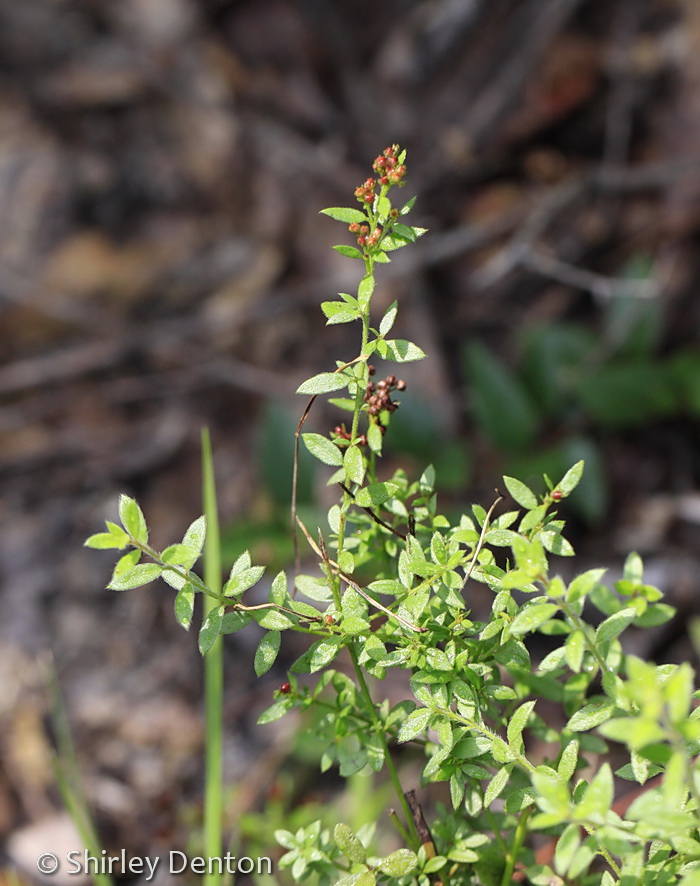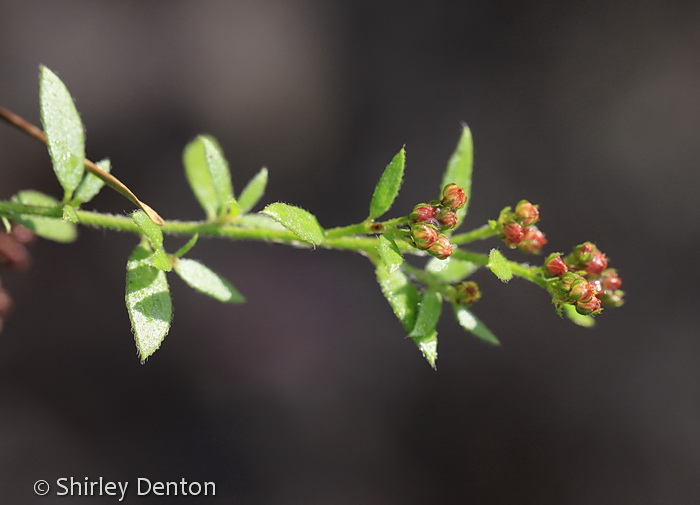Lechea minor
| Lechea minor | |
|---|---|

| |
| Photo by Shirley Denton (Copyrighted, use by photographer’s permission only), Nature Photography by Shirley Denton | |
| Scientific classification | |
| Kingdom: | Plantae |
| Division: | Magnoliophyta - Flowering plants |
| Class: | Magnoliopsida – Dicotyledons |
| Order: | Violales |
| Family: | Cistaceae |
| Genus: | Lechea |
| Species: | L. minor |
| Binomial name | |
| Lechea minor L. | |

| |
| Natural range of Lechea minor from USDA NRCS Plants Database. | |
Common name: Thymeleaf pinweed[1]
Contents
Taxonomic notes
Synonym: Lechea thymifolia Michaux[1]
Varieties: none[1]
Description
This species can be frequent where it occurs. [2]
"Perennial herbs with taproots and basal rosettes of procumbent, leafy stems late in the season; early stems erect, several from a crown, freely branched above, appressed or spreading pubescent. Leaves opposite, subopposite, whorled or subverticillate on the lower part of the stem, usually alternate above, usually short-petiolate; leaves of the winter rosettes usually whorled or subverticillate. Inflorescence of scroppoid cymes or racemes in a panicle or theyrse. Sepals 5, outer 2 linear, inner 3 elliptic to ovate; petals 3, reddish or maroon, usually shorter than the sepals; stamens mostly 5-15; stigmas 3, red, plumose. Capsule 1-3 seeded; seeds reddish-brown or brown ca. 1 mm long." [3]
"Stems appressed pubescent, 2-7 dm tall with mostly spreading ascending branches; principal stems 1-2 mm in diam. Leaves oblong to elliptic, spreading to spreading-ascending, 6-12 mm long, 1-3 mm wide, glabrous above, ciliate, pubescent beneath mostly on the midrib and near the margins; leaf arrangement similar to no. , but opposite and whorled arrangement often higher into the inflorescence; petioles ca. 1 mm long. Inner sepals are shorter than the capsule, 1-1.5 mm long, outer slightly longer. Capsule ellipsoid 1.2-1.7 mm long, 0.7-1 mm broad, 3-seeded." [3]
Distribution
This plant's range extends north in Massachusetts and Vermont, west to southern Ontario and northern Indiana, and south to Florida and Louisiana.[1]
Ecology
Habitat
This species is found in sandy soils in open fields, open bogs, and longleaf pine forests. [2] It also occurs in human-disturbed areas such as powerline corridors and old roadbeds. [2] Associated species include Longleaf pine and wiregrass. [2]
Lechea minor is an indicator species for the Clayhill Longleaf Woodlands community type as described in Carr et al. (2010).[4]
L. minor was found to be neutral in its long-term response following cessation of repeated soil disturbance.[5]
Phenology
This plant flowers July through August and fruits August through October.[1]
Seed dispersal
This species is thought to be dispersed by consumption by vertebrates. [6]
Seed bank and germination
Several short-lived perennial forbs also have a seed bank persistent for at least several years.[7]
Fire ecology
L. minor can grow in areas that are annually burned[2] as shown by populations that have been known to persist through repeated annual burning.[8]
Conservation, cultivation, and restoration
Cultural use
Photo Gallery
Lechea minor Photo by Shirley Denton
(Copyrighted, use by photographer’s permission only)
References and notes
- ↑ 1.0 1.1 1.2 1.3 1.4 Weakley, A.S. 2020. Flora of the Southeastern United States. Edition of 20 October 2020. University of North Carolina at Chapel Hill, Chapel Hill, North Carolina.
- ↑ 2.0 2.1 2.2 2.3 2.4 Florida State University Robert K. Godfrey Herbarium database. URL: http://herbarium.bio.fsu.edu. Last accessed: June 2014. Collectors: Robert K. Godfrey, Kevin Oakes, and R. Komarek. States and Counties: Florida: Leon and Franklin. Georgia: Baker, Grady, and Thomas.
- ↑ 3.0 3.1 Radford, Albert E., Harry E. Ahles, and C. Ritchie Bell. Manual of the Vascular Flora of the Carolinas. 1964, 1968. The University of North Carolina Press. 720-1. Print.
- ↑ Carr, S.C., K.M. Robertson, and R.K. Peet. 2010. A vegetation classification of fire-dependent pinelands of Florida. Castanea 75:153-189.
- ↑ Dixon, C. M., K. M. Robertson, A. M. Reid and M. T. Rother. 2024. Mechanical soil disturbance in a pine savanna has multiyear effects on plant species composition. Ecosphere 15(2):e4759.
- ↑ Kirkman, L. Katherine. Unpublished database of seed dispersal mode of plants found in Coastal Plain longleaf pine-grasslands of the Jones Ecological Research Center, Georgia.
- ↑ Platt, W. J., S. M. Carr, et al. (2006). "Pine savanna overstorey influences on ground-cover biodiversity." Applied Vegetation Science 9: 37-50.
- ↑ Glitzenstein, J. S., D. R. Streng, R. E. Masters, K. M. Robertson and S. M. Hermann 2012. Fire-frequency effects on vegetation in north Florida pinelands: Another look at the long-term Stoddard Fire Research Plots at Tall Timbers Research Station. Forest Ecology and Management 264: 197-209.
